#writing system
Explore tagged Tumblr posts
Text

Starting to wrap up the writing system on my new language. Hope I can share what I have (relatively) soon! For now here's a sneak peak
#conlang#constructed language#conscript#constructed script#artlang#neography#orthography#writing system#i forgot how much work making a writing system is#very happy w how this is turning out
41 notes
·
View notes
Text

Lexember #17: Tway
Tway [twaj] ‘be unable to, be incapable.’ Spelled with the semantic determiner / radical for POWER and the phonetic determiner tay, ‘ankle,’ represented by a foot with a mark on the back. Functions as the negative equivalent of nûng ‘able, can.’ I think I’ve mentioned before that Tepat has several “negative” verbs that might be considered suppletive negatives of common verbal meanings. This is one of them
31 notes
·
View notes
Text

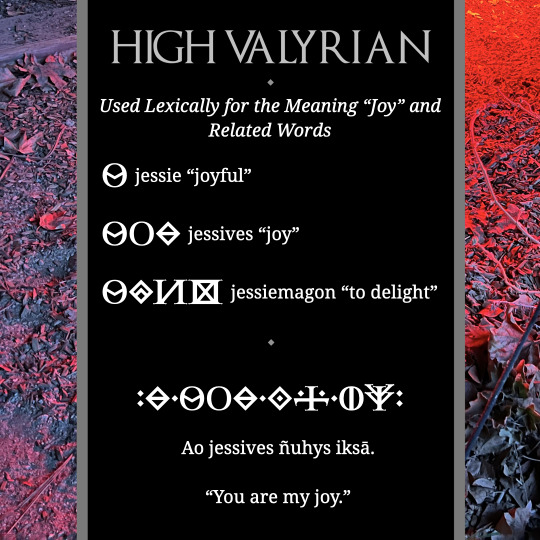
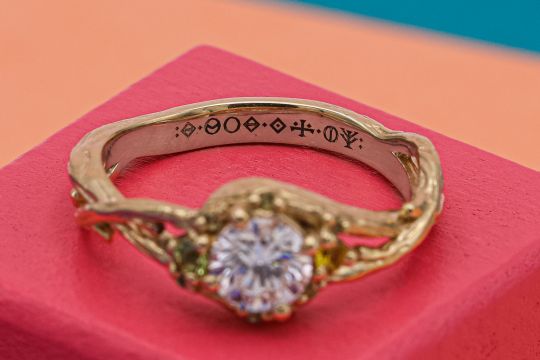

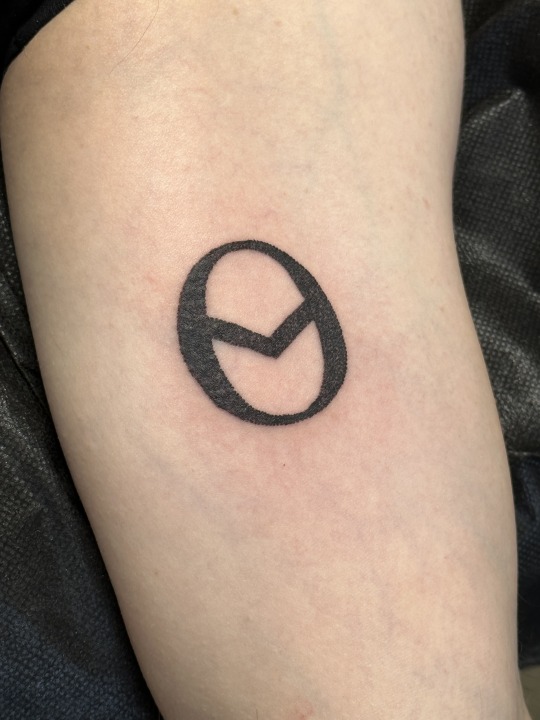
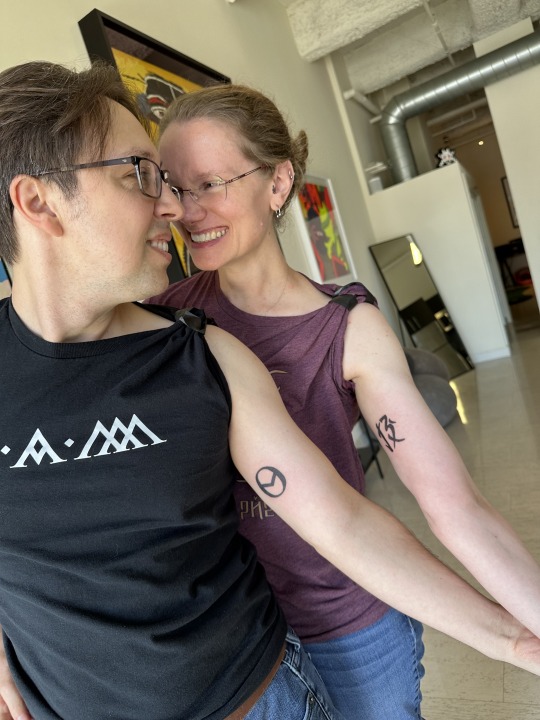
The High Valyrian adjective jessie "joyful" was coined in honor of my fiancée, Jessie Sams, and the glyph was made thinking of her. I've known Jessie for ten years at this point, but our lives led winding paths that eventually led us to each other. We started working together in 2019 on Freeform's Motherland: Fort Salem, and I've wanted to work with no one else ever since. When I proposed to Jessie, I gave her a ring with a Valyrian inscription inside. That inscription featured her name glyph: Ao jessives ñuhys iksā, which means "You are my joy".
I'd never planned on getting a tattoo in my life, but we came up with an idea that meant a lot to both of us. I'd created a glyph for the word "joy" in High Valyrian and based the sound of that word on Jessie's name. She, in turn, had created a word based on my name in her language Zhwadi (it means "create"). Her writing system is also logographic, so there's a character associated with that. Consequently, we each decided to get each other's "names" tattooed on ourselves. Now a part of us will always be with the other. :)
#conlang#language#game of thrones#house of the dragon#got#hotd#valyrian#high valyrian#quothalinguist#zhwadi#orthography#neography#conscript#constructed script#writing system#tattoo
179 notes
·
View notes
Note
i think i have a crush on a writing system.. it's called sitelen sitelen and oughhh it's so cool and and 😳
https://sona.pona.la/wiki/sitelen_sitelen i love itttt...
OHHHHEHRHRHRHRHRHR EVERYONE GO LOOK AT THIS -> LINK <- NOWWWW!!!!!!!!
8 notes
·
View notes
Note
woaw is that a conlang
yes it is! it's called Nezai and i've been working on it for--
IT'S BEEN FIVE YEARS??? sorry i just can't process time anymore im going crazy
uh but yeah! i made a conlang! i do have a whole google spreadsheet for the words, but it's very inconsistent and nothing makes sense. it's like a real language! (except it's a priori and there's only like one generation of etymology)
the writing system is.. uh? well you've seen it. the direction of the fricatives and nasals point in the reading direction, and /e/ always points the opposite way. a dot on top indicates voicedness.
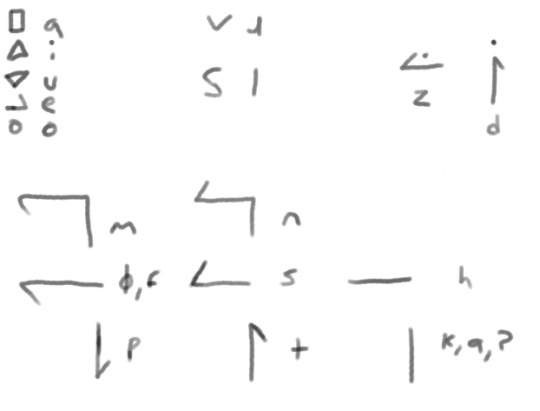
i get away with a system this simple because there aren't a lot of (distinct) phonemes in Nezai. /j/ is in there, but it's covered by /i/, and /w/ is covered by /u/.

"nezai" is written like above (my handwriting is horrible though sry)
there's an older (unrelated) writing system, but i won't get into it, it's a mess. ^^'
word order is VSO and there are too many noun cases.
àzhainoriten n'amitana no (NEG-have-1-INDEF-idea\good to-stop-SS- 3.ABSTR VIA)
18 notes
·
View notes
Text
Shout out to handwritten Cherokee
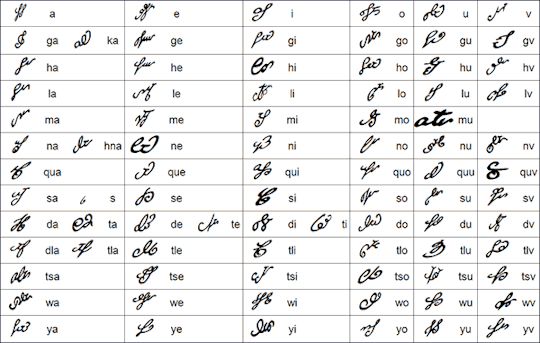
33 notes
·
View notes
Text
Does anyone recognize this writing system?

I did this a number of years ago as a LARP prop, and am dead certain I borrowed this alphabet* from somewhere. For the life of me I cant remember, and it's going to bug me forever. I thought it was some generic nerdy shit, but Google proved unhelpful.
*not sure if alphabet or other writing system. potentially a syllabary
9 notes
·
View notes
Text

Lexember 2023 Master Post
Lyak - Pay, Tûn - Swûl, Nôt - Tsaltep, Kyeng, Ngyûp - Ngôw, Lum, Lûn, Kôn - Klup - Lôy - Luke - Han - Neng, Mûl, Nôk, Lit - Swûq, Hyat - Xûl - Swim - Tsapay - Win, Wip - Kyuk, Mey, Ngan, Lin - Thung, Xhûp
(All posts tagged Lexember)
#lexember#conlang#yuktepat#tepatic glyphs#logograph#writing system#conworld#conculture#worldbuilding
69 notes
·
View notes
Text
Minecraft Conlang!
I recently started making a conlang in minecraft which will technically be my first “real” conlang.
It is still unnamed and mostly unfinished.
let me know if you have any questions, tips, and or suggestions in my asks.
goals:
my goal for this conlang was to make a system of writing / preserving information in a way that felt more like it was part of the world as opposed to just using text on signs.
I also thought it'd look cool for worldbuilding purposes.
It is meant to be accessible to those who are in the early stages of the game. If they have a crafting table and access to any type of wood and or stone, they can write in this conlang. (I try to avoid using stairs and fences/walls too much since those cost a lot of blocks and can't be substituted/remade into full blocks like slabs can).
this post covers basic grammar and vocabulary. For more, see these other posts:
Causality
Pronouns
Nouns

(from left to right)
-any type of block—also used to describe structures: (a block)
-a player: (two block pillar)
-a mob: (three block pillar)
-a projectile: (a two block pillar with one block adjacent to the top one)
-item / tool: (two blocks placed adjacent to each other on the ground)
Verbs
Verbs are placed such that the verb is above and adjacent to the uppermost block of the noun (subject) they are connected to on the side that points towards their object.

(left to right)
-to exist (at); to be still: (one block)
-to create: (two block pillar)
-to attack; to damage; left click: (a slab)
-to consume; to use; right click: (slab with another slab a half a block above it)
-to emit any type of (sensory) information; to be perceived by something: (a slab that is up by half a block)
-to turn into; to become: (one block with a slab that is half a block above it)
-to jump (over/towards): (a slab with a block above it)
-to move (towards): (a slab that is up by half a block with a block on top of it)
-to sneak (past/towards): (a block with a slab on top of it)
Simple Structures
in a simple sentence, the verb is connected to the subject and points to the object.


(left to right)
“mob is perceived by player” or “the player perceives the mob”
“player becomes items” or “the player dies”
Multiple Verbs & Multiple Objects
a noun can have up to 4 verbs connected to its main body. Below is an example of a noun with 2 verbs connected to its main body.
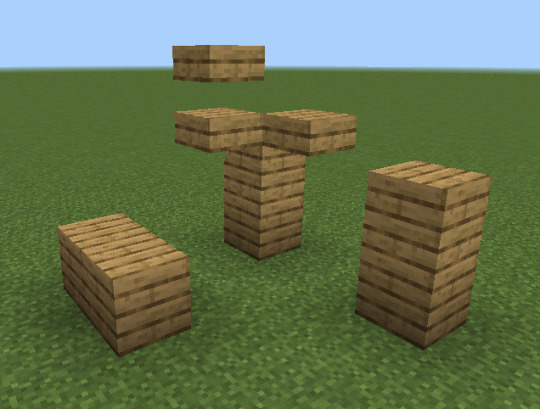

both of the above structures say “player-A hits player-B and consumes an item”
verbs can also be strung together as seen below.

this structure (also) says “player-A hits player-B and consumes an item”
these strings can be any length but it’s better for them to be shorter (2-5 blocks long).
placing a stair in a string of verbs means to skip the noun that the stair would’ve been applied to if it were a verb.

“the projectile damages a mob” (the player is skipped over)
strings can even “overlap” and form structures like this:

these events do NOT occur in a specific order. I’m just describing it this way so it’s easier to follow.
(if read from left to right) this structure says:
“projectile-A damages mob-A.
mob-A attacks player-A and creates mob-B.
player-A creates projectile-A (skipped mob-A because of the stair).
mob-B damages player-A.”
this could be describing a fight between a bow-wielding player and an evoker (since evokers “create mobs” (vexes) )
Describing Things by Using Hypotheticals
this part of the language takes inspiration from UNLWS and is also kind of like of how someone might describe particularly complex things in toki pona.
hypotheticals can be used to add context to what something is by placing that thing in a hypothetical scenario.
like the most recent sentence, one can imply what is being spoken about through context (that the above sentence could describe a fight between a player and an evoker).
but, if someone feels as if there isn’t enough information to imply things through context or that they just want to describe a standalone thing in detail, they can use hypotheticals.
all nouns have an alternate form for when they are being used in a hypothetical scenario.

(left to right)
Hypothetical forms:
-any block: (a stair)
-player: (a slab with a block above it)
-mob: (a slab with a two block pillar above it)
-projectile: (a slab with a block above it and another block adjacent to the above block)
-item / tool: (two slabs that are adjacent to each other and half a block above the ground)
when real nouns are used alongside hypothetical ones, the hypothetical nouns add context which describes the real noun.

the above structure says "a mob (which attacks a hypothetical player)" which could describe a hostile mob.

the above structure says "a mob (that attacks a hypothetical player and damages hypothetical blocks)"
this could describe a creeper (since they both destroy blocks and attack the player).
notes
this is pretty much all I have right now. This language is 3 dimensional but most of the examples are 2D since it's easier to take pictures of them that way.
this is a shortened version of what I have as of now and I left some things out.
things that I made for this language but I left out/might change:
number system
ways to describe coordinates
describing the size and shape of terrain and builds
a crude way of ordering nouns chronologically
things I might want to do:
time (night, day, etc.)
tenses
negation
some of the current verbs seem basically useless so may I want to either change their functions or alter their meanings
#conlang#wip#conscript#minecraft#nonlinear#nonlinear conlang#nonlinear writing system#writing system#UNLWS#toki pona
5 notes
·
View notes
Text
bored at work so i took a little break to write out my intro post in my conscript :) sorry it’s so sparkly the only pen i had on me was a glittery gel pen lol

#conlang#constructed language#linguistics#gamlieg#language creation#conlang translation#conlanging#conscript#writing system
24 notes
·
View notes
Text
The Collective Seraphic Writing System
This post is going to be the one dedicated to explaining how the Seraphic writing system works. This writing system is entirely digital, as physical writing is no longer in everyday use throughout the Collective, so it's a bit inconvenient to actually write out. It's also weird to read, because it's written in a way that makes the assumption that you know how to speak and understand Seraphic, but I'll try to explain what I can.
Seraphic has two written forms: longform and shortform. Longform is used primarily to teach young instars how to read and write, and as a way to show how a shortform word is meant to be read. Shortform is the main form of writing, and due to its complication it's usually put off for a year or two before being taught in pupariums. Shortform is the method I'll be teaching today. It's primarily morpho-phonetic, with elements of both an alphabet and grammatical logograms, and is written bottom-to-top and right-to-left in reverse boustrophedon (the path of writing goes up, flips 180°, and goes back down). Because of this, you're expected to be able to read both right-side-up and upside-down. For this post, I'll be using an example sentence to highlight specifics areas of the writing system, as shown below:

It reads: nJasāğn k'œ̄nan ālxōr e-fya.
"There are 16 dull knives on the floor."
There are seven elements you need to be aware of when writing in Seraphic: the alphabet, class cartouches, procedural and plural ligatures, preposition glyphs, tone diacritics, numerals, and punctuation. I'll be going through each one step-by-step.
Alphabet

The alphabet makes up the majority of Seraphic writing. There are 30 consonants and 6 vowels, and they all arrange into syllable blocks called "cells". Each consonant takes one of three forms depending on if it is at the start of the syllable, before a vowel, or at the end of a syllable. The alphabet is featural, meaning that the way each letter is written is meant to encode its pronunciation. Here is the alphabet in full:

Each consonant (excluding the ejectives) showcases the three variant forms it can take (similar to capital and lowercase letters in the latin alphabet). The largest, leftmost character is the form that hosts the interior vowels within it. The rightmost vertical form is used when preceeding another consonant, and the upmost horizontal form is used at the end of syllables. If a syllable contains a syllablic consonant, the main consonant will have no vowel within it and instead a syllable-final form of one of the syllabic consonants (r, l, m, n, or ŋ) placed on top of it.

Concerning vowels, they are solely meant to be written within consonants, acting sort of like internal diacritics. They cannot exist on their own, nor can more than one be written within the same consonant (Seraphic doesn't allow diphthongs), and if a vowel must be written by itself it is written within the glottal stop letter ' (in this instance acting as an independant vowel holder).

These rules apply to individual syllables. In multi-syllabic words, each syllable cell is arranged together in a specific way based on the number of syllables in order to keep the line uniform and compact.
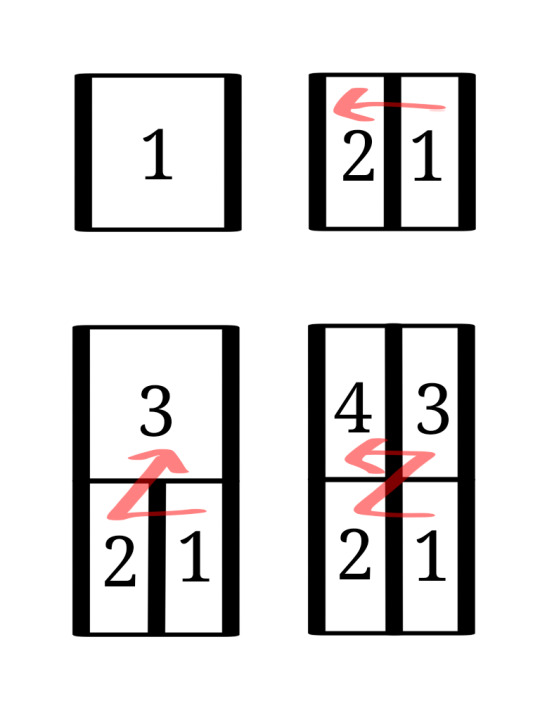
the flow of reading word-internally definitely follows the overall direction of writing (bottom-to-top, right-to-left) so broken down an entire word will usually look like this when written:
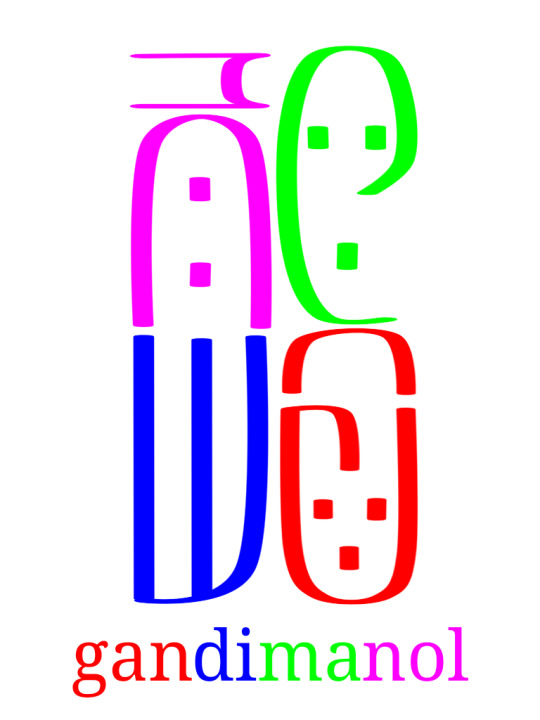
Seraphic written in longform will be written entirely using the alphabet. Spaces are put between words, punctuation and numeral symbols are still used, and tone diacritics may be included as well, but otherwise it's entirely spelled out in this way. Writing this way makes the text as a whole quite longer, and can come off as childish or imply you're a new learner of Seraphic, so shortform will usually be used in official contexts. In shortform, alphabetical letters are restricted to non-declined parts of nouns, adjectives, and proper nouns.
Class Cartouches

In Seraphic, there are seven noun classes: Solar (people), Astral (animals), Vital (plants), Terranean (places), Metallic (objects), Lunar (concepts), and Oceanic (everything else). Similarly, the writing system employs seven symbols called "class cartouches" to encode which noun class a word is in. This is drawn from this writing system's predecessor, the Aeonic Seraphic alphabet, that also used glyphs to notate class. These are the seven noun class cartouches:
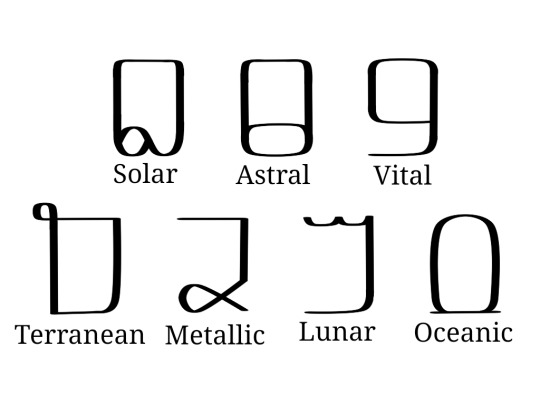
The thing about the class cartouches is, not only is it morphological, but it's also phonetic. A noun is never spelled out in its entirety, usually only part of it is. When a class cartouche is used, it's supposed to stand in for the class prefix itself without having to additionally spell the class prefix in the rest of the word. For example, in the word zājlux (tail), the "-jlux" would be spelled out, and the solar class cartouche would be drawn around it to stand in for the "zā-". Even though you don't write it, you still know it's there because of the class cartouche. Because of the nature of the noun class prefixes, and how many different forms they can take, it can be daunting to have to guess if you're supposed to pronounce a word with a "za-" or a "zo-", but there are patterns to which prefix (and thus, declension patterns), is meant to be read depending on what the following sound is.
Solar class
read as zā before f, v, s, z, c, j, pf, ts, tc and any cluster of two consonants (e.g. zāsā, zāfr, zājlux)
read as zō before x, ğ, h, ', and kx (e.g. zōxō, zōxur, zōğœcl)
read as zē in stressed syllables, and occasionally before consonant clusters (e.g. zēzmp'ux, zēzt'e, zēvasax)
read as s before vocalics (vowels and syllabic consonants), r, l, w, y, n, t, d, p', or k' (e.g. srāc, sēr, sōğœc)
read as ts before t', the ts replacing the t' entirely in pronunciation, for example tsn would be written as (Solar)t'n (e.g. tsn, tsā, tsłzaf)
Astral class
read as ğr before f, v, s, z, c, j, x, ğ, h, pf, ts, tc, kx, p', t', k' and and cluster of two consonants (e.g. ğrzles, ğrxur)
read as x before vocalics, r, l, w, y, ŋ, k, g, p', or t' (e.g. xūc, xŋox)
read as kx before k', the kx replacing k' in pronunciation (e.g. kxa)
Vital class
read as wā before r, l, w, or y (e.g. wāya, wārāc, wāwax)
read as wō before k', k, g, x, ğ, ŋ, or kx (e.g. wōk'ł, wōxur, wō'ōf)
read as wē before consonant clusters (e.g. wēzles, wējlux, wējlozln)
read as ū before n, m, p', p, b t', t, d, f, v, s, z, c, j, pf, ts, or tc (e.g. ūt'u, ūp'n)
read as w before vocalics (e.g. wē, wīn, wājr)
read as wī occasionally before consonant clusters (e.g. wīzya)
Terranean class
read as va before f, v, s, z, c, j, pf, ts, tc and any cluster of two consonants (e.g. vafl, vasērn, vasa)
read as vo before x, ğ, h, ', kx, and consonant clusters (e.g. voxāl, vodsā, vojrayux)
read as vu in stressed syllables and occasionally before consonant clusters (e.g. vujlux, vulvren, vuzajni)
read as f before vocalics, r, l, y, w, m, n, ŋ, p, b, t', or k' (e.g. fe, fruvn, fmağo)
read as pf before p', pf replacing p' in pronunciation (e.g. pfan)
Metallic class
read as ja before f, v, s, z, c, j, pf, ts, tc and any cluster of two consonants (e.g. jafa, javlni, jawaya)
read as jo before x, ğ, h, ', and kx (e.g. joxl)
read as c before vocalics, r, l, w, y, n, t, d, p', or t' (e.g. can, cya, cenaŋx)
read as tc before t', the tc replacing the t' entirely in pronunciation (e.g. tcłvr, tcāŋğl, tcū)
Lunar class
read as la before r, l, w, or y (e.g. lara, layeğr, lalel)
read as lo before k', k, g, x, ğ, ŋ, or kx (e.g. loxir, loğn̄, loxel)
read as le before consonant clusters (e.g. levp'ā, levren, lejt'ān)
read as li in stressed syllables and occasionally before consonant clusters (e.g. liwayi, lit'n̄, livasāx)
read as y before vocalics (e.g. yar, yu, yawu)
read as l/ł before n, m, p', p, b t', t, d, f, v, s, z, c, j, pf, ts, or tc (e.g. lce, łzēwok'u, lvulvren)
Oceanic class
read as a/ā before m, n, p', p, b, t', t, d, s, z, f, v, c, j, pf, ts, tc, w, r, y, l, and all consonant clusters (e.g. ap'i, āt'ē, ācèya)
read as o/ō before ŋ, k', k, g, ', x, ğ, h, and kx (e.g. ōxūr, ōxān)
read as aw/āw before vocalics (e.g. awun, awaf, awaman)
Of course these rules are not hard set, and there are several instances where a written word contradicts these rules or even when two words end up spelled the same, but for the most part these rules will generally be consistent for most written words. It seems like a lot to remember, but usually it's a thing that you eventually develop a sort of "ear" for.
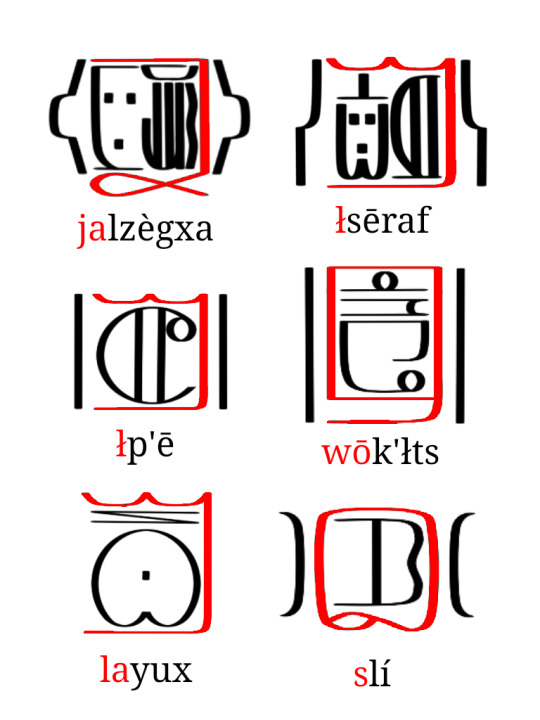
Procedural and Plural Ligatures

The procedural and plural ligatures are additional glyphs used to mark, respectively, the procedurals and the plurals of a noun. The procedural are written at the bottom of the noun (since Seraph is written bottom-to-top and these are prefixes of course), and there are 12 separate procedural symbols in use. Similarly, the plurals, being suffixes, are written at the top of the noun and contain only three symbols (the singular is usually unmarked). They are as follows:
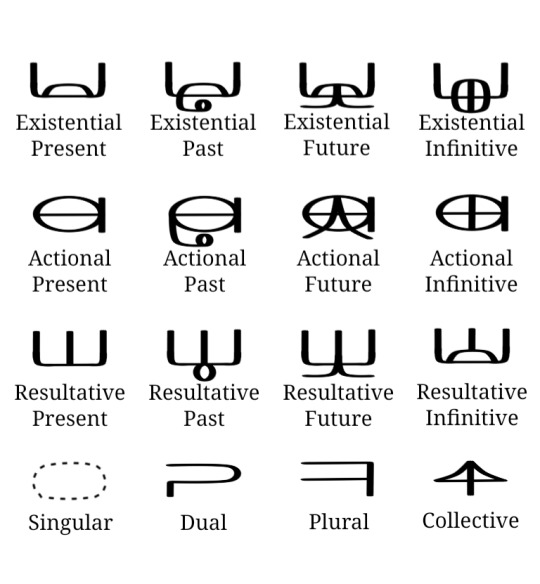
The plural ligatures attach to both nouns and adjectives freely, but in order for a procedural ligature to attach to an adjective, the adjective needs to be put in the oceanic class and subsequently written with the oceanic class cartouche. Additionally, if you want to write remote past/future forms for each procedural, you would need to attach the resultative present ligature underneath the preexisting past or future ligature (these conjugations haven't developed their own separate ligature forms, so they follow the tradition of using the resultative in addition as semantically that is where the remote forms originated). I don't really have a way to show you how to pronounce the plural forms, as even though the different pronunciations are pretty few they're actually pretty inconsistent on which one goes where. It's just one of those things you kinda have to already know. You can check the introduction to Seraphic post to see what forms the plurals can take, but otherwise it's basically, like, memorization. The procedurals on the other hand DO have a predictable pattern of pronunciation, but each tense has a different form based on what class and declension the noun is in, and with six tenses and seven classes each with at least three different declension forms, it's definitely something I can't summarize here. Again I HAVE to make a separate post for that because the declension forms are vital to knowing how to decline properly in Seraphic.
Preposition Glyphs

This section will probably be the easiest to explain really. The preposition glyphs are pretty easy to recognize. They're written in between words, attaching to both of them instead of floating freely like regular words are. There are 19 glyphs for the 19 prepositions, and they don't really change form. Sometimes, if occurring at the beginning of a sentence, they'll have one end sorta lopped off, but not everyone follows through with this convention. Here are the glyphs listed below:
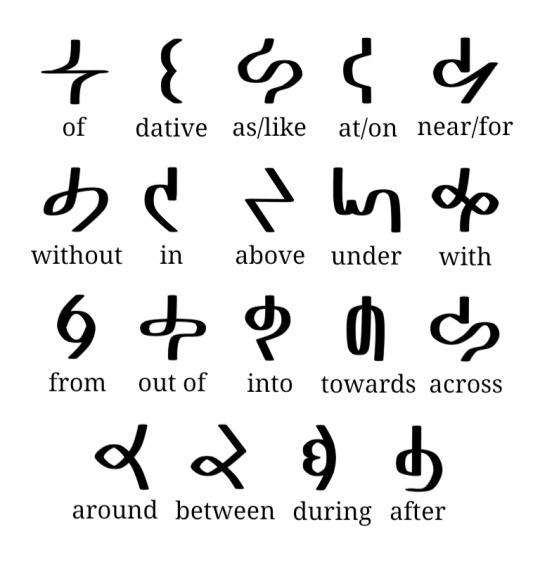
Two or more prepositions can't occur sequentially, it's a very one-at-a-time situation, although in colloquial speech you'll see two prepositions being used in certain instances.
Tone Diacritics

Seraphic is a tonal language, and luckily it has diacritics to indicate the tones. They frame the words on each size, being used on both nouns and adjectives where applicable. You'll usually see them in formal contexts like government documents and letters of address, on signs and boards and menus and any kind of display especially in highly populated areas, in use by those whom are just learning Seraphic and don't have a hang on remembering all of the tones yet, and just in any context where clarity of literacy would be important. In everyday colloquial text conversations and things the tone diacritics will be usually dropped as context is sufficient enough to know, although tone diacritics may be reintroduced to differentiate homonyms that are distinguished only in tone (e.g. lxal "power" vs. łxāl "day"). There are eight individually recognized tone diacritics:
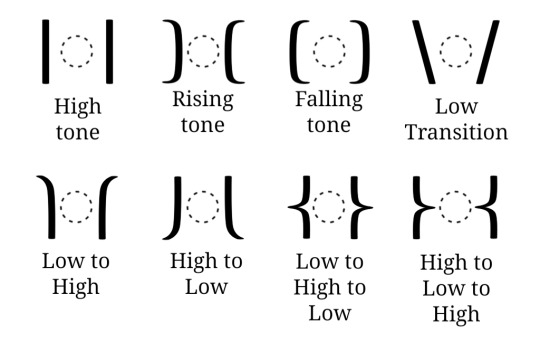
The low tone is the base tone and is usually left unmarked, so there's no sign for just the low tone. When a low tone transitions to a rising or falling though, the low transition diacritic will be used to connect the two. Many of these diacritics are usually connected consecutively when a word requires it, flowing as if they're one larger tone diacritic. This can give a whole host of unique tone symbols, but for the most part, all of the tone symbols can be broken down officially into the 8 diacritics. There isn't a 1-1 correspondence between individual tone diacritics and syllables within a word, usually you can know from context and just knowing how the word is pronounced. For example, the word łxāl would be written with one high tone marker even though the word is two syllables, but it's meant to infer that the entire word is pronounced with an even high tone. Here are some additional examples:
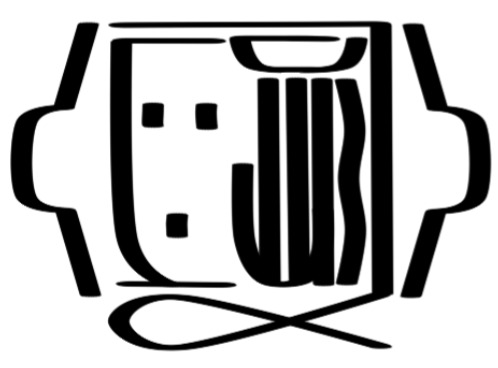
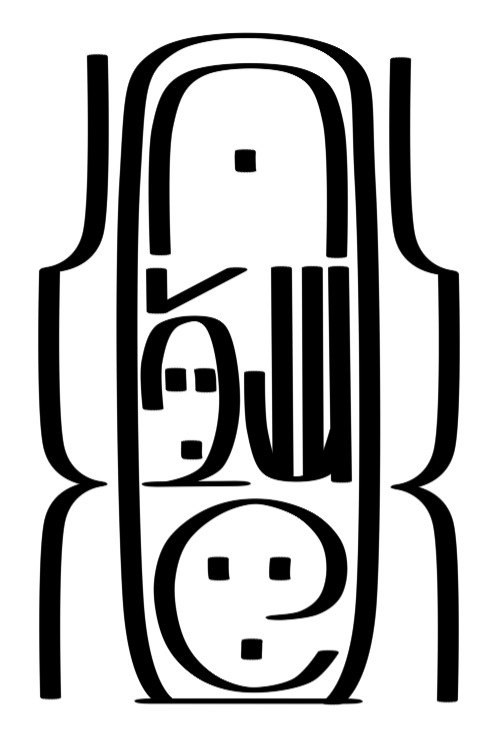
The top example is the word jalzègxa "chronicle". You can see that it uses the two low tone transitions to connect to the central falling tone, representing a low-falling-low relationship. The word below that is māzefādnu "hourglass". It employs a high-low-high, and then a high-low, with the last high-low meant to merge with the high-low-high. So truthfully it's meant to be interpreted as high-low-high-low. There's a lot of possibilities, but breaking it down will simplify what tones are being used specifically.
Numerals and Punctuation

This final section will discuss Seraphic numerals and punctuation. Now, unlike in most human languages which uses base-10, having 10 unique symbols to represent the values of 0-9, Seraphic uses base-16 and represents the values 1-16 with 16 individual symbols. In base 16, we would write 16 as 10, standing for one set of 16 and zero sets of 1. It's written in positional notation like arabic numerals, where each position represents a power of 16 (instead of a power of ten like in base-10). Here are the numerals:
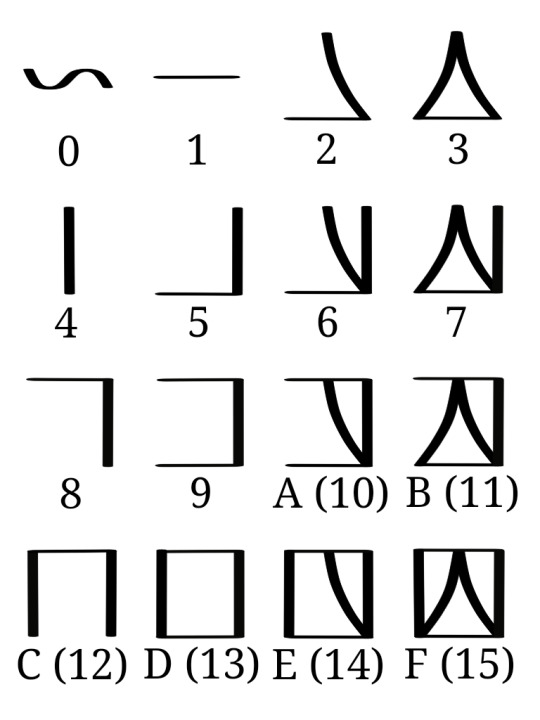
If you were to write a number like 299,792,458; you'd convert it into base-16 which would be 11,DE7,84A; and since Seraphic numerals are grouped in 4 instead of 3 it would actually be 11DE,784A. This is how you'd write that:
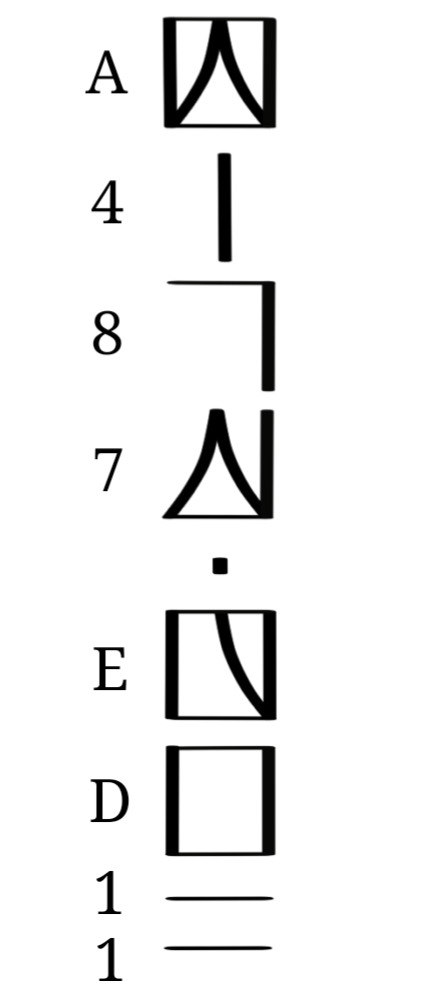
Both Arabic numerals and Seraphic numerals describe the same amount of things, they just group things differently. We group in sets of 10, they group in sets of 16.
As for punctuation, there are only 5 marks that's in standard use, and these are them:
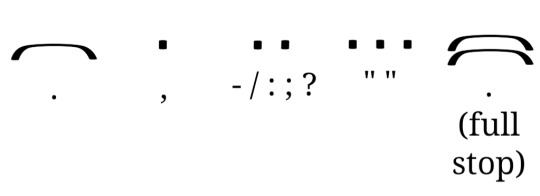
Single bar - separates individual sentences.
Single dot - separates clauses for clarity, separates numerals into groups of four.
Double dot - separates individual words such as in lists or replaces a single dot when separating clause groups.
Triple dot - Distinguishes quotes and dialogue, as well as highlighting names, terms, and titles.
Double bar - used to end full paragraphs/passages instead of a single bar.
Overall, that's pretty much everything I can detail about how the Seraphic writing system works! It's complicated but it was very fun to develop and boy was it satisfying to get it to work. Hopefully you'll now be able to decode a little better Seraphic writing, and maybe even write something of your own!

ŋKowīci cu-stux 'ōf tsa-levp'ā cu-zāsláf pi-lizt'n ğōdjasa! (Thank you all so much for reading!)
#conscript#constructed script#neography#conlang#constructed language#artlang#writing system#orthography#seraphic#collective seraphic#whoa boy this one is even longer#had to do a lot of writing and doodles for this#of course i needed them so itd all make sense#i needed to provide examples#either way i hope this made any sort of sense#ill provide the declension forms soon enough and that should be relatively shorter#idk if it'll be easier to explain though#eh whatever
52 notes
·
View notes
Text
2024 Lexember #8: Khûl

RE: previous Lexember post Mup (2024, #1) - Recall that Qathûq had gathered his sorcerers in pursuit of various magical projects.
Today’s word khûl [kʰɯl] means ‘nerve’ or ‘nervous tissue.’

Spelling: The semantic radical (“meaning” component) on the left side is a body. On the right side is the phonetic radical (“sound”) - which is the previous Lexember word xûl ‘finger joint’ - indicating that this word [kʰɯl] sounds close to [xɯl]. An alternate version of the glyph has the semantic THREAD on the left, because nerves are thread-like.
Now to discuss what we might call Tepatic “brainworms.”
They may be called wet i-khûl ‘worms of the nerve’ or nel-khûl ‘nerve crawlers’ or other other terms. Recall that previous Lexember word nel means ‘crawl’ or ‘slither’ - but also ‘lead astray.’

Above: wet i-khûl and nel-khûl
But my preferred word is khûy khûl [kʰɯj kʰɯl].

Above: khûy-khûl
Khûy means ‘little i’ and refers to a little mark representing the sound i, which means ‘of’ or ‘that,’ and is written above and next to larger characters in some texts as an abbreviation of sorts.

It is also a colloquial term for small worms, because the tiny half-loop looks like a tiny worm.
Returning back to Qom: Previously said among other things, he sought to create enchanted worms that would crawl under people’s skin and control their minds. This was developed from a disease. There was a legend that a sorcerer long ago had created animate worms from clay, which could move according to his instruction. But the worms escaped into the wild, infesting animals and people. Now free and without any guiding creator, they did not manipulate people in any purposeful way, but still wandered and burrowed, causing shifting sensations and consciousnesses of all sorts. These are the “brainworms,” a rare but feared disease.
Brainworms are difficult to treat, but still easier than sarcopetrosis, which is hopeless. But it is difficult, and often painful. The worms have to be located, and they can move. If they are still crawling under the skin, the skin can be cut open. If they move into organs such as the spinal cord or brain, they can become impossible to remove. They can be suppressed by the use of antimagical drugs such as phasmoctone, but these can also suppress the patient’s own vitality as well. If not used with great care, the patient can die from the treatment as well. On the other hand, the disease is difficult to spread.
Previously Qathûq had expressed interest to his prime minister, Silhen i-Tsyam, in the latter’s teacher Xhalkil, a biologist who pioneered operant conditioning, and wondered about its social uses. He conveyed that to his magicians, who found a diseased patient from whom they could get worms, and develop them into tools - the goal being for magical worms to burrow into people and manipulate internal energy flow, altering it to cause pleasure or pain to control behavior.

#lexember#conlang#yuktepat#tepatic glyphs#writing system#logograph#worm#conworld#worldbuilding#magic#disease
43 notes
·
View notes
Text
Doodles featuring my logography (W.I.P) Amaranscript


5 notes
·
View notes
Text
Testing out a possible hidden watermark using a writing system called tendrilis by Anomalis

It reads: Glitchypyro do not repost without permission
6 notes
·
View notes
Text
She-Ra: The Princesses of Power Headcanons.
Non-human Scripts
Being a conlanger and having a blooming interest in the story and lore of the SR-PoP series, I have come up with, at most, three writing systems for the Scorpioni (Scorpia's people), Magicats (Catra's People), and Draconids (Rogelio's People). Disclaimer, aside from the Scorpioni script, the other two are based on, hopefully, popular writing systems from other pieces of fiction. Other than that, I will talk about how these scripts work, some cultural head-canon of how each script can be utilized, and where I got the inspiration for each one. With all that said, let's begin.
Scorpioni
The way the Scorpioni script works is that a pincer-bearing individual cuts shapes along the edge of a thin flat surface. Like paper... or sheet metal (we all saw how powerful Scorpia's pinchers were when they cut through that guard rail). Due to the nature of this system, "books" or, more accurately, "scrolls" or, even more accurately, "reels" are the most common form of information keeping among Scorpioni peoples where entire works can be read continuously by unspooling the thin strips. Recently, Scorpioni have taken to laminating these sheets as to preserve the cut-out parts from wear and tear.
Reels are not the only form of medium for "writing" as during special occasions, holidays, weddings, introducing your new best friend(s) to the clan, and so on, will see the exchange of "paper stars." these beautiful fractal crafts are constructed by folding paper and cutting into the folded edge. When unfolded, that message becomes a pattern that varies depending on the types of folds used and the types of "flourishes" a writer implements while cutting. It is considered by many to be the Scorpioni equivalent to calligraphy.
I lied, lol. The basis for the Scorpioni script is based on Trent Pehrson's Krapi Script. However, the idea of a script being cut rather than written by dragging a trail on a medium, I feel, come from me. I might also implement this system for my Splatoon worldbuilding project for the crab people.
Magicat Script
The Magicat script is literally handwritten in that the writer will make swooping patterns with one or more of their claws (or fingers for regular humans). Historians say that this tradition started with the Magicats scratching marks into trees and, later, stone with their claws before transitioning to ink and paper.
Speaking of which, magicat scribes are known as "night-tracers" with how them constantly dipping their claws into ink have stained them and their fingers dark.
This script is inspired by the Hani and their writing system. Which I unashamedly took wholesale. I might modify it if I ever get the interest and drive to develop this and the others.
Draconid Script
I'm going to break structure here by saying that Draconid is literally the Dinotopian Footprint Alphabet. Perhaps the scaly lizard people originally wrote this script by stomping patterns into the soft ground and those patterns got adapted to being written by hand. Maybe there are some cuneiform-style logographs as well.
This is all that I have, for now. Feel free to use any of these head canons in your own works just forward them to me when you do.
Thank you for reading all of this. Take care and I'll see you next time... ;).
#mvtjournalist speaks#neography#conscript construction#conscript creation#neographilia#she ra and the princesses of power#she ra catra#she ra fanfiction#she ra scorpia#she ra rogelio#rogelio#catra#scorpia#magicats#scorpioni#draconids#she ra headcanons#writing systems#writing system#headcanon#head canon#fan fiction
2 notes
·
View notes








